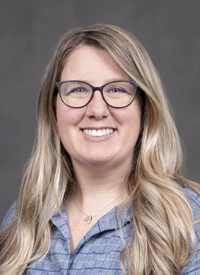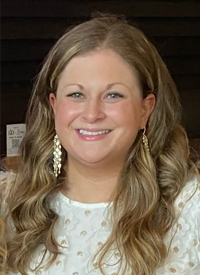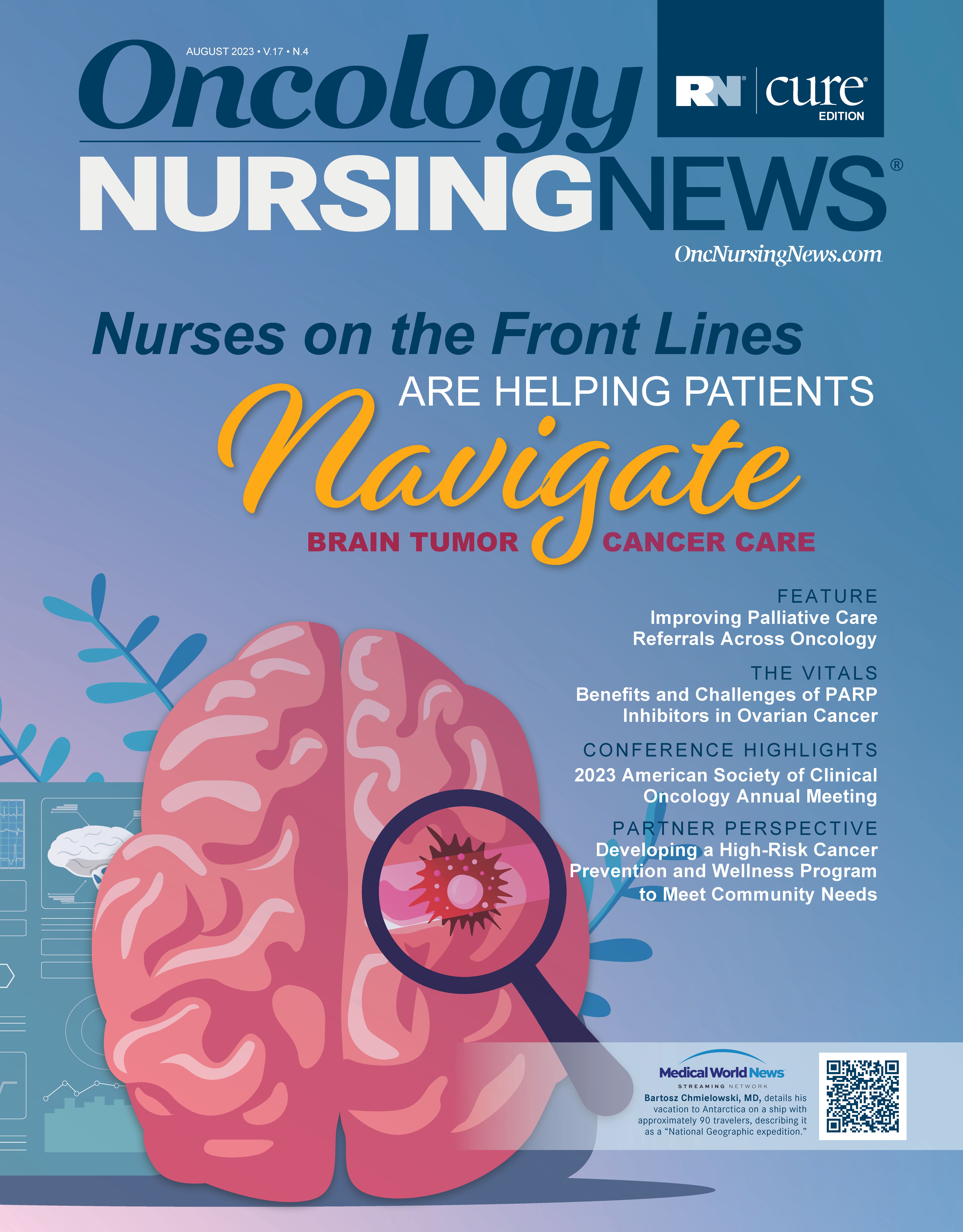Improving Palliative Care Referrals Across Oncology
Oncology nurses across the country are spearheading initiatives to improve education, attitudes, and access surrounding palliative care.
Sarah Espe Lewis, MNE, RN, OCN, a palliative care nurse navigator at the Knight Cancer Institute at Oregon Health & Science University (OHSU) in Portland, has seen how palliative care is often misunderstood by patients, nurses, and other members of the medical community.
Sarah Espe Lewis, MNE, RN, OCN

“Often, no one has taken the time to talk with oncology patients about how palliative care can be beneficial,” Lewis said in an interview with Oncology Nursing News. “Patients equate palliative care with hospice care, when palliative care—also referred to as supportive or comfort care—can actually help with any type or stage of cancer and improve a patient’s quality of life even as they pursue curative treatment.”
Although palliative care and hospice care have very similar goals—to reduce and manage pain for patients with serious illnesses—they also differ in some key ways. Unlike with hospice care, patients can enroll in palliative care at any time during their treatment trajectory. Further, patients do not need to discontinue potentially curative treatments to receive palliative care.1
As Lewis noted, oncology nurses who specialize in palliative care are experts in symptom management and can help patients cope with pain, depression, nausea, and other adverse effects during cancer treatment. When social workers are embedded in the palliative care team, patients receive additional psychological and emotional support.1
Since the physical and emotional effects of cancer vary from one patient to the next, palliative care addresses a wide range of issues, including physical symptoms, emotional and coping needs, spiritual needs, caregiver needs, and practical needs including finances and insurance concerns. Yet, despite studies showing the benefits of palliative care when used alongside cancer-directed therapy, referrals remain inconsistent and underutilized.2 According to the World Health Organization, each year an estimated 56.8 million people, including 25.7 million in their last year of life, could benefit from palliative care, yet only 14% of patients worldwide who need palliative care currently receive it.3
To improve guidelines for referrals, oncology nurses across the country, including Lewis, are spearheading initiatives to improve education, attitudes, and access surrounding palliative care. At the Knight Cancer Institute at OHSU, 2 palliative care nurse navigator positions were created in fall 2021 to educate patients about the role of palliative care.
“Between January and August 2021, we had a cancellation rate of 24% among patients with cancer who had been referred to our palliative care clinic,” Lewis said. “The role of the new nurse navigators was to connect with newly referred patients before their first appointment and educate them on the wide variety of services we can provide them through palliative care.”
Lewis, who is one of the nurse navigators, explained that the appointment cancellation rate dropped to 17% between September 2021 and August 2022, exceeding the goal of a 5% reduction and suggesting that the initiative is working.
“Many patients have expressed that they mistakenly believed a palliative care referral meant they would be meeting with hospice,” Lewis said. “While palliative care is used to ease the suffering in patients with latestage disease, it can also help patients at any stage of their cancer journey if they are experiencing pain, nausea, and emotional [adverse] effects as a result of their treatment.”
A New Screening Tool Helps With Assessments
To help oncology nurses better determine who would benefit from palliative care, the oncology staff at Nebraska Medicine in Omaha have started using ID-PALL, a screening instrument used to distinguish between general and specialized palliative care needs.
Meredith Hellman, BSN, RN, OCN

Meredith Hellman, BSN, RN, OCN, a nursing professional development specialist in medical and surgical oncology at Nebraska Medicine, told Oncology Nursing News that oncology nurses began using ID-PALL in August 2021 on their medical-surgery oncology unit. They are believed to be the first medical professionals in the United States to use the new screening tool.
“Our staff nurses [had previously] reported difficulty identifying patients in need of palliative care and articulating those needs to providers,” Hellman said.
Using ID-PALL, oncology nurses at Nebraska Medicine answered a series of questions on behalf of their patients. Part 1 (7 items) identifies patients requiring general palliative care and part 2 (8 items) identifies patients requiring specialized palliative care. Each item is based on a yes-or-no response, with 1 positive response to any item considered the cutoff to require either generalized or specialized palliative care.
General palliative care includes basic symptom management and provides care for patients on the basis of individual needs, not diagnosis. Specialized palliative care is provided for patients with more complex needs by a multidisciplinary team at an advanced level and can include psychologists, social workers, and other specialists.
A study conducted in Switzerland used ID-PALL to assess over 2000 patients and compared the results with a clinical gold standard evaluation performed by palliative care specialists. The study concluded ID-PALL was an effective and accurate screening tool that could be used by doctors and nurses without specialized palliative care training.4
MaryPat Porinchak, BSN, RN, OCN

“The ID-PALL is used by nurses to screen patients on day 3 of their admission to the hospital or with any change in their condition,” Hellman said. “The tool can be used by both nurses and doctors based on their clinical observations and by answering questions related to the patient’s symptom burden, such as shortness of breath and uncontrolled pain.”
Hellman said nursing staff report the ID-PALL helps them better identify patients who would benefit from palliative care and helps them better advocate for palliative care with a patient’s doctor.
“The information obtained from ID-PALL also provides the palliative care team with meaningful information that can be used to create a tangible road map for each patient,” Hellman said. “If a patient is screened and doesn’t warrant palliative care, but [then] has a change in their condition, nurses can redo the screening.”

Guiding Patients on End-of-Life Treatment Decisions
Sometimes it is not easy to determine whether a patient should be referred to palliative or hospice services.
As a palliative care patient access nurse at Memorial Sloan Kettering Cancer Center (MSK) in New York, New York, MaryPat Porinchak, BSN, RN, OCN, frequently receives calls from oncology patients and their families who have exhausted all curative options and are seeking information on new cancer treatments or clinical trials.
“I recently had one patient’s family call after their loved one had been admitted to hospice following 7 unsuccessful lines of [chemotherapy],” Porinchak said. “They told me MSK was their Hail Mary, and they wanted to know if anything else could be done to help their loved one.”
Porinchak and the other palliative care access nurses at MSK walk a fine line between giving patients and their families hope and speaking with them candidly about their loved one’s diagnosis.
“The patient in hospice was not prescribed further cancer-directed therapy,” Porinchak explained. “I spoke to their family about how aggressive treatments for patients with a terminal disease can be ineffective, causing pain, suffering, and increased hospitalizations.”
According to Porinchak, between August 2021 and August 2022, the Patient Access Service at MSK received 68,193 new visit requests. Among those who were not scheduled, 2348 patients were not scheduled because of clinically driven reasons, such as an Eastern Cooperative Oncology Group poor performance status. However, following careful review, some of these patients were found to be candidates for palliative care.
Instead of pursuing curative treatments that wouldn’t work and could even hasten the patient’s deterioration, Porinchak said patient access nurses discuss goals of care with the patient and their family.
"It’s changing the narrative from cancerdirected care to educating patients and their families about how palliative care can increase their comfort and quality of life,” Porinchak said.
In some cases, Porinchak has escalated patient cases to the Medical Oncology Service chief of oncology for review to determine whether additional cancer treatments could prove beneficial and whether the patient’s condition was stable enough to safely travel to MSK for treatment.
“Patients and caregivers benefit from nurse-led guidance resulting in earlier access to palliative care, and patient access nurses have a high degree of readiness to have effective end-of-life conversations,” Porinchak said.5 “We always tell [patients] to call us. Our door is always open.”
References
1. What are palliative care and hospice care? National Institute on Aging. Reviewed May 14, 2021. Accessed July 6, 2023. https:// bit.ly/3ra3mGU
2. Ferrell BR, Temel JS, Temin S, et al. Integration of palliative care into standard oncology care: American Society of Clinical Oncology clinical practice guideline update. J Clin Oncol. 2017;35(1):96-112. doi:10.1200/JCO.2016.70.1474
3. Palliative care. World Health Organization. August 5, 2020. Accessed July 6, 2023. https://bit.ly/44zMyYs
4. Lüthi FT, Bernard M, Vanderlinden K, et al. Measurement properties of ID-PALL, a new instrument for the identification of patients with general and specialized palliative care needs. J Pain Symptom Manage. 2021;62(3):e75-e84. doi:10.1016/j. jpainsymman.2021.03.010
5. Porinchak M, Amato L, Culkin A, Heffernan N. Transitioning to palliative care: the delicate art of guiding patients on end-oflife treatment considerations. Poster presented at: 48th Annual Oncology Nursing Society Congress; April 26-30, 2023; San Antonio, TX. Accessed July 6, 2023. https://bit.ly/3PNnid1
6. Jensen-Seaman K, Hebert RS. Palliative care education in nurse practitioner programs: a survey of academic deans. Nurs Educ. 2016;41(3):130-133. doi:10.1097/ NNE.0000000000000247
7. Cohen MG, Althouse AD, Arnold RM, et al. Primary palliative care improves uptake of advance care planning among patients with advanced cancers. J Natl Compr Canc Netw. 2023;21(4):383-390. doi:10.6004/jnccn.2023.7002

Shared Model of Care Post-HCT Offers Safe Follow-Up, Reduces Patient Burden
Published: March 19th 2025 | Updated: March 19th 2025Alternating post-HCT care between specialized facilities and local cancer centers produced noninferior non-relapse mortality and similar quality of life to usual care.



